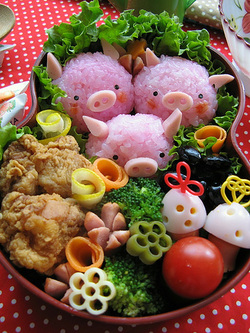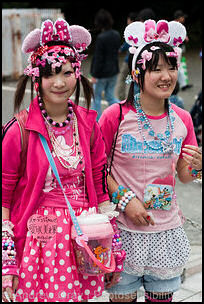
Grodinsky “The Joy of Soy” chapter 3 from
A Taste of Health
Miso and soy sauce, both soy products, are used in one way or another in just about every dish in Japanese cuisine.
Soy Sauce:
consumption:
Popularity:
MISO:
Consumption:
Fermented Soybean Products and Japanese Standard Taste by Erino Ozeki
Standard Taste As a Cultural Model
Standard Taste: The Japanese Case
Origins of the Components
Dashi components:1.) kombu
Hishio - salt fermented food such as grains, fish, meat, or vegetables.
The Persistent Nature of the Standard Taste
The strength of the Standard Taste (people are returning to it, even though so many exotic/foreign options are available).
Ongoing and Prospective Changes
A Taste of Health
Miso and soy sauce, both soy products, are used in one way or another in just about every dish in Japanese cuisine.
Soy Sauce:
- first known reference to “soy sauce” is from 1597 in the Ekirinbon Setsuyoshu as “tamari shoyu”
- soy sauce came later due to the machinery needed to create it (squeezing liquid from the beans)
- not easily done at home like miso
- Noda is where commercial production became and it still remains prominent
- 50 yrs or so passed and they had arranged the flavor with half roasted wheat and half soy beans and created their pure product of “shoyu”
consumption:
- In the 18th century 14.5 liters per year per person of soy sauce were being consumed.
- Nowadays it’s down to about 9 liters per year per person.
Popularity:
- 17th century, Japan began exporting soy sauce (now it exports to 100 countries)
- Soy sauce grew in popularity during WWII because of American Soldiers returning home after time in Japan
- 1957, in the USA soy sauce sales were growing at about 15% a year
- 1973, Kikkoman opened factory in Wisconsin (otherwise soybeans woudl always be exported to Japan, then imported BACK in as soy sauce - a waste of everything!)
MISO:
- “In many ways, miso is to Japanese cooking what butter is to French cooking and olive oil to the Italian way.” - Shizuo Tsuji, Japanese Cooking: A Simple Art
- 8th century there was miso but it wasn’t shared by everyone until about 12 century (mostly likely due to Buddhism encouraging simple diets) which helped define a “simple” meal of rice, miso soup and pickles.
- There is a huge variety of miso (similar to that of the variety of cheese in France).
- Also a huge variety of HOW it is made (some made with rice, barley, dark, light, sweet, salty etc...)
- Until about 1960s miso was made at home.
Consumption:
- A Japanese eats a few tablespoons of miso per day (according to stats)
- It can be used in soup, as a marinade, sauce, pickling, dishes like dengaku, nabe...
Fermented Soybean Products and Japanese Standard Taste by Erino Ozeki
Standard Taste As a Cultural Model
- we recognize a repeated flavor/taste eventually as a cuisine
- instances where people return to their childhood flavors include: shocked by exotic flavor/living for a long period of time in foreign place
- our original childhood flavor preference is what we judge all other flavors by
- Standard taste is often misunderstood and takes the form of a stereo typed food item in a culture
- this this usually the product of ingredients/seasonings etc... simply being uncommon
- In history availability of foods and “suitable processing and cooking methods” guided taste
- in ca be influenced by introduction of foreign products (such as red hot pepper in Korea)
- discovery of using ingredients differently etc... (soy over fish in modern Japan)
- “Standard tastes are deeply associated with particular ingredients and specialized preparation techniques”
Standard Taste: The Japanese Case
- Two Major Elements: dashi and fermented soy bean products
- these tow could have been pivotal due to “Umami cultural area”
Origins of the Components
Dashi components:1.) kombu
- first mentioned in Shokunihongi AD 797
- first used for dashi in Genroku Period (1688-1704)
- Dried fish (particularly katsuo-bushi)
- eaten as early first century BC (Yayoi Era)
- eighth century AD (Nara Era) references to it as dried fish and boiling it became common
- the name didn’t appear till Muromachi Period (1333 - 1573)
Hishio - salt fermented food such as grains, fish, meat, or vegetables.
- 1.) salted soy and grain varieties 2.) salted fish and meats 3.) pickled vegetables
- By the end of the Edo Period skills and procedure had improved miso
The Persistent Nature of the Standard Taste
- About a thousand years passed between the introduction of jiang/miso and katsuobushi and it as a standard taste
- It was early 19th century when miso, shoyu, kombu, katsubushi became affordable
- then it developed as a steady and “persistent” standard taste
The strength of the Standard Taste (people are returning to it, even though so many exotic/foreign options are available).
- Slow food movement has been spurred by mass media showing homecooking as “traditional” and “authentic” - anti-fast food movements
- However fast food still is moving along, through other ways such as convenience stores
- now customers want high quality and fast at the same time
- Both Fast food and Slow food are moving towards more traditional ways
Ongoing and Prospective Changes
- Changes that have occurred:
- ready made instant dashi (loss of patience for slow home cooked dashi)
- miso/shoyu/fermented soy products have become lighter in flavor (no longer needed for preservation and health awareness)


 RSS Feed
RSS Feed